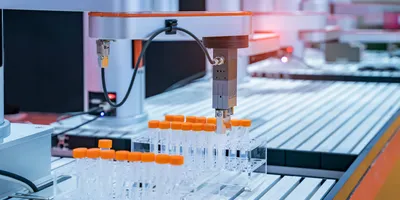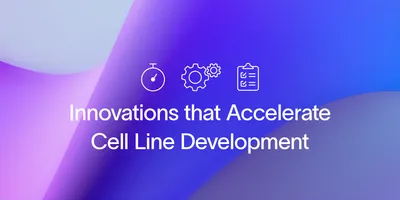Most labs are facing constant pressures to achieve more, be more productive, and deliver these outcomes with greater efficiency. Lab automation technology can provide the levers labs need to meet these constantly rising expectations.
To learn more about how pharma labs can benefit from new approaches to automation, we spoke with Robert Dunn-Dufault, an R&D manager at Thermo Fisher Scientific, who has extensive experience in drug discovery, development, and lab automation.
Q: Let’s discuss the current lab digital landscape. Where are pharmaceutical labs today in terms of their ability to automate?
A: There has been a big push within the last few years for labs to utilize digital solutions to help streamline everything from small molecule drug discovery to cell culturing, but there’s still a lot of variability when it comes to preparedness to work with a fully automated workflow. Historically, lab automation has been most impactful in drug discovery where labs need to deliver consistent, scalable results while eliminating the chance of manual errors. This has largely been achieved on integrated hardware platforms.
Labs today are now looking to automate more operational tasks to set the lab up for success and are finding it more challenging to automate previously manual tasks than expected. This next round of automated workflow will have to go beyond implementing robotic processes, such as tracking samples, barcode scanning, and liquid handling steps. It will be the total capture and orchestration of all laboratory activities—hardware, software, and people tasks combined that will allow labs to remain competitive. This digital transformation is necessary to combine the forces of traditional standalone lab equipment with new technologies to ultimately bring scientific discoveries to the forefront faster.
Q: What is driving the pharmaceutical industry to consider adopting new technologies?
A: The pharmaceutical industry’s primary goal is to get life-changing therapies into the hands of patients who need them most quickly without compromising safety and efficacy. From a research and development (R&D) perspective, digital technologies are driving to accelerate the drug discovery and development timeline, which can significantly reduce costs.
Innovative, advanced therapies, such as biologics, are also driving the pharmaceutical industry to adopt new technologies. Last year alone, the FDA approved 50 novel drugs, 38 percent of which were biologics. The drug discovery and development process for these therapies can be long and arduous, so streamlining the research, development, and manufacturing process is as important as the drug itself. With new technologies, the journey from early discovery to clinical application can be greatly simplified, shortening the time to patient treatment.
Additionally, with digitally connected solutions, labs are inching closer to the potential to deliver more personalized medicine for patients across disease states, such as cancer, due to regular monitoring and faster analysis of results in a cost-effective way.
Q: Which technologies will be critical to accelerate the shift to fully autonomous lab operations?
A: As labs look to shift to fully autonomous operations, integrating digital aspects of lab automation such as artificial intelligence (AI), internet of things (IoT), cloud computing, and machine learning (ML) can enhance day-to-day activities such as data entry and analysis. The distribution of work between automated systems and software versus people will continue to change as technology progresses. Currently, the digital transformation allows for deeper connectivity across robotic platforms, which is an essential part of the shift. For example, when labs are able to leverage autonomous mobile robots (AMRs) and camera systems, scientists can seamlessly track and move samples between instruments and islands of automation, and track tasks with intgrated vision systems. Layering in orchestration software to capture all tasks can further enhance the experience and get pharma labs closer to fully autonomous work.
Advanced Lab Management Certificate
The Advanced Lab Management certificate is more than training—it’s a professional advantage.
Gain critical skills and IACET-approved CEUs that make a measurable difference.
Q: In what ways can automation enhance the pace of innovation in R&D?
A: Laboratory automation has long been at the heart of innovation in pharmaceutical R&D. As we look to the future, automation combined with the power of AI will have an even bigger impact on the pharmaceutical industry as it progresses due to its ability to process more information at a much faster rate. By freeing scientists from working on manual tasks, they will have the time to focus on reaching novel insights and making breakthrough discoveries.
Q: How can lab automation help labs align with current and emerging regulations?
A: Automation can enable data integrity and security, which are paramount to traceability and documentation requirements of current and emerging regulations. Software within the lab can show what changes were made to a workflow, as well as who made the changes and when. Labs can engage in seamless auditing with these technologies and show that they are upholding high quality assurance and control while producing reliable, repeatable, and scalable results. Effective digital solutions should securely capture everything going on in the lab and directly support regulatory filings.
Q: How can automation support reproducibility and data integrity in scientific research?
A: Automation and digitally enhanced workflows can generate data with standardized processes, which leads to more reproducible results. How we collect the data, how it is stored, and how it is controlled are all big parts of supporting data integrity. By adding digital solutions to the lab, the risks that come with poorly captured manual workflows can be eliminated.
Q: What challenges remain in implementing fully autonomous systems in regulated environments like pharmaceutical R&D or manufacturing?
A: In some cases, determining which processes are best suited for automation and autonomous operation is the first hurdle. But when we’re thinking about industry-wide challenges, ensuring regulatory alignment is essential. Making sure that labs can quickly validate processes, engage in traceability, and ensure that their data is secure is required at every stage along the drug development journey. For technology providers, developing autonomous robotics platforms in ways that are directly suitable for pharma companies to implement into existing workflows remains a critical piece of the equation.
Advanced automation and digitalization will enable scientists to spend more time thinking about the science and spend less time managing lab tasks and activities. The rise of powerful software applications will provide opportunities to convert data into information and knowledge faster.
Bio:
Rob Dunn-Dufault is a research and development manager at Thermo Fisher Scientific with over 20 years of experience in drug discovery, development, and laboratory automation. He previously held project management roles at Patheon Inc. and SignalGene Inc. Rob holds a Master’s in Pharmaceutical Sciences from the University of Toronto and a Bachelor’s in Chemistry and Philosophy from the University of Guelph.














